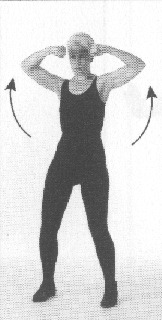
Fig. 270
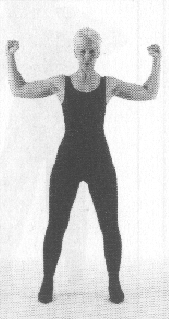
Fig. 271
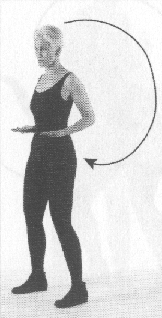
Fig. 272
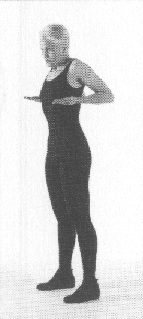
Fig. 273
The third group consists of nine magical passes that employ inhalations and exhalations as their driving force to either further separate or join the two bodies. As already stated, in the view of the sorcerers of don Juan's lineage, putting a dab of energy from one body into any vital center of the other creates a much sought-for momentary agitation in that center. The sorcerers of ancient Mexico, according to what don Juan taught, considered this mixing to be extremely beneficial because it breaks the fixed, routine input of those centers. Those sorcerers felt that breathing is a key issue in the separation of the left body and the right body.
31. The Breath for the Upper Fringe of the Lungs
The arms, with the hands clenched into fists, are raised to the forehead with a deep inhalation; the palms of the fisted hands face down. The fists are three or four inches from each other, right in front of the forehead, as the inhalation ends (fig. 270). An exhalation is made as the arms spread forcefully to two lateral points to the sides and even with the shoulders (fig. 271). The hands relax and open. The wrists cross in front of the head and a deep inhalation is taken as the arms make two big circles the length of the arms, going from the front, up over the head, and to the sides. The inhalation ends as the hands come to rest by the waist, with the palms up (fig. 272). A slow exhalation is made then, while the hands are raised along the edges of the rib cage, to the level of the axillae. The exhalation ends as the shoulders are pushed up, as if the force of the hands were making them rise (fig. 273).
This breath is a true bonus because it allows the mobilization of the
upper part of the lungs, a thing which hardly ever happens under normal
conditions.

Fig. 270 |

Fig. 271 |

Fig. 272 |

Fig. 273 |
32. Offering the Breath
The left arm draws a circle as a deep inhalation is taken. It moves from the front to above the head, to the back, to the front again; as the arm rotates, the trunk turns to the left, to allow the arm to move in a full circle. The inhalation ends when the circle is completed. The palm of the hand is held at the level of the chin; it faces up, and the wrist is bent at a ninety-degree angle. The posture of the practitioner is that of one who is offering something which is placed on the palm. The trunk is bent forward (fig. 274). The palm of the hand is then turned to face down, and an exhalation begins while the arm moves slowly and powerfully downward (fig. 275) to rest on the left side by the thigh; the palm is still facing down, and the back of the hand maintains the ninety-degree angle in relation to the forearm.
The same sequence of movements is executed with the right arm.
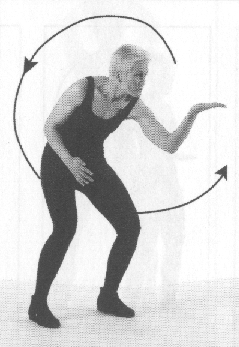
Fig. 274 |
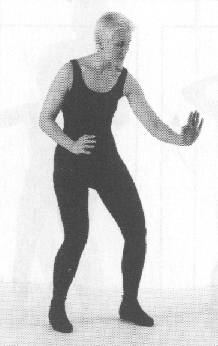
Fig. 275 |
33. Moving Energy with the Breath from the Top of the Head to the Vital Centers
The wrists of both arms are slightly bent; the palms of the hands are semicurled. With the hands in this position, the tips of the fingers brush upward along the front of the body and over the head as a deep inhalation is made (fig. 276). When the arms reach their full extension above the head, the hands are straightened and the wrists are turned back at a ninety-degree angle. The inhalation ends there. While the hands are brought down, the air is held, and the index finger of each hand is raised; the other fingers are held against the palm, bent at the second knuckle, and the thumbs are locked. Both arms are retrieved to the level of the chest, with the back of the hands against the axillae.
A deep exhalation begins then as the arms are slowly extended straight
forward until the elbows are gently locked. A deep inhalation then is taken
as the hands are retrieved back to the position against the axillae, still
with the index fingers raised, the wrists bent backwards, the palms facing
forward. A slow exhalation begins while the hands move upward in a circle
that first reaches above the head and then continues downward, making a
complete forward circle without changing the position of the index fingers.
The hands come to rest by the sides of the rib cage (fig. 277). The exhalation
ends as the hands are pushed downward to the sides of the hips.
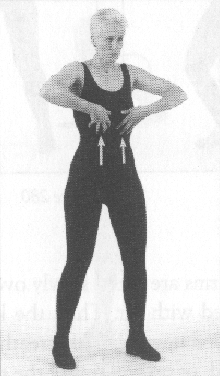
Fig. 276 |
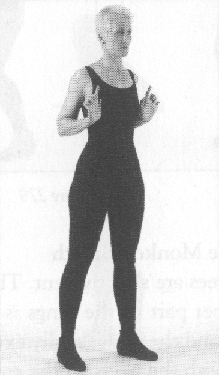
Fig. 277 |
34. Shattering Energy with the Breath
As a deep inhalation is taken, the left hand moves in a wide side circle from the front, to above the head, to the back. The trunk turns to the left to facilitate the full rotation of the arm. The inhalation ends when the arm has made a full rum and stops at a place to the side of the head and above it. The palm of the hand faces forward; the wrist is slightly turned back (fig. 278). A slow exhalation begins then as the arm makes another wide side circle in the opposite direction, going from the front down to the back, then above the head, and to the front again. When the circle is completed, the arm is brought to a point just in front of the right shoulder as the exhalation continues. The palm is facing the body and lightly touches the right shoulder (fig. 279). Then the arm shoots out laterally with the hand clenched in a fist and strikes, with the back of the hand, a point an arm's length away from the left shoulder at the height of the head (fig. 280). The exhalation ends there.
The same sequence of movements is repeated with the right arm.
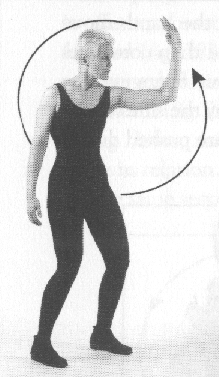
Fig. 278 |
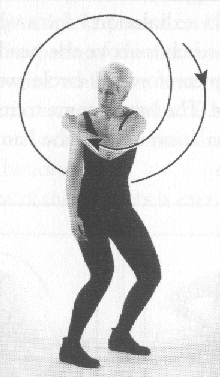
Fig. 279 |
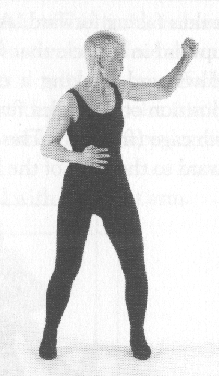
Fig. 280 |
35. The Monkey Breath
The knees are slightly bent. The arms are lifted slowly over the head as the upper part of the lungs is filled with air. Then the knees become locked and the body is fully extended upward. This breath can be taken either with the heels on the ground, or on the tips of the toes.
The breath is held as the arms move downward and the body stoops lightly forward, contracting the diaphragm; the knees are bent again. The exhalation begins when he hands reach the level of the waist. At the same time, the index fingers are extended and point to the round;, the other fingers are contracted over the )alms of the hands. The hands continue moving downward as all the air is exhaled (fig. 281). While exhaling, the diaphragm is held tight in order to avoid pushing it downward with the exhaling air.
36. The Altitude Breath
The legs are held as straight as possible. An inhalation begins while the shoulders slowly rotate from he front to the back with the arms bent at the elbows. When the rotation and the inhalation end, the arms are kept in the initial position (fig. 282). The exhalation begins by raising the hands to the level of the shoulders and extending the arms as far forward as possible with the palms facing the ground.
Next, an inhalation is taken as the palms of the hands are turned upward. The elbows are bent and pulled all the way back, and the shoulders are raised. The inhalation ends with the maximum upward stretch of the shoulders (fig. 283).
An exhalation is made as the palms are turned to face the ground and
the hands and shoulders push downward; the hands are bent backward at the
wrists as far as possible, and the arms are held straight at the sides
of the body.
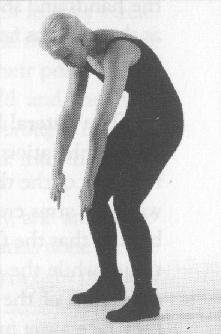
Fig. 281 |
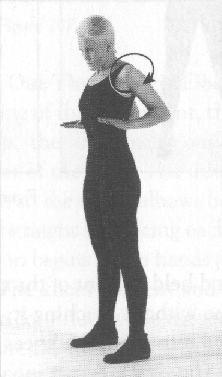
Fig. 282 |
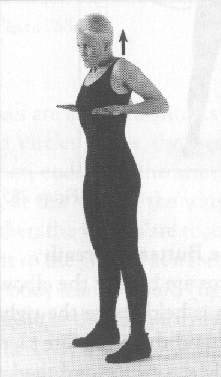
Fig. 283 |
37. The Lateral Breath
As an inhalation begins, the arms move from their natural position by the sides of the thighs in a circle toward the center of the body, ending with the arms crossed; the palms face outward, and the wrists are fully bent so that the fingertips point upward (fig. 284). The inhalation continues while the two arms are pushed out laterally. As the arms move, the palms of the hands first face forward; when the movement ends, they face away from each other. The inhalation ends at the maximum extension of the arms. The body is kept as erect as possible (fig. 285).
An exhalation is made by bending the arms at the elbows as the palms
of the hands, with the fingertips raised upward, come toward the center
of the body, pass it, and cross to end at the opposite edges of the body.
The left forearm is on top of the right. The body is contracted at the
midsection, and the knees are bent (fig. 286).
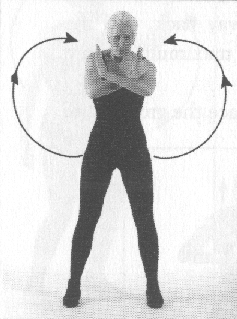
Fig. 284 |
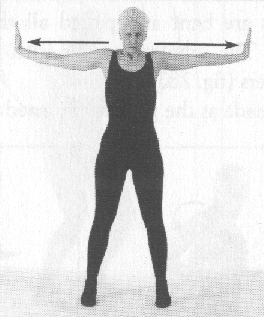
Fig. 285 |
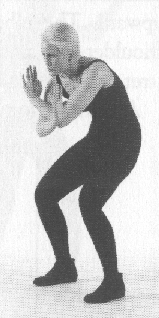
Fig. 286 |
38. The Butterfly Breath
The arms are bent at the elbows and held in front of the chest. The left forearm is held above the right one without touching it; the wrists are straight and the hands are clenched into fists. The knees are bent, and the body stoops forward markedly (fig. 287). As an inhalation begins, the arms separate and move up over the head and out to the left and right. As the inhalation continues, the arms straighten as they circle, going down, to the sides, and around the shoulders, and then fold back to their initial position over the chest. Maintaining their position, the arms are raised over the head, as the breath is held and the body straightens at the waist (fig. 288). Then the arms are brought down to the level of the umbilical region as the body goes back into the initial stooped-forward position, with bent knees.
The body holds that stooped-forward position steadily, and an exhalation
is made by repeating the same movements of the arms done for the inhalation.
As the air is expelled, the diaphragm is kept in a tight position.
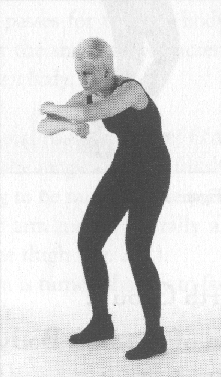
Fig. 287 |
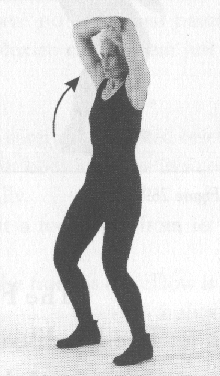
Fig. 288 |
39. Breathing Out Through the Elbows
At the beginning of this movement, the legs are kept straight. As a deep breath is taken, the arms make outward circles above the head and around the sides of the body. The inhalation ends with the arms pointing straight out to the front, elbows bent, at the level of the waist. The palms are held straight and facing each other; the fingers are together.
An exhalation begins as the hands point to the ground at a forty-five-degree angle. The knees are bent and the body leans forward (fig. 289). The exhalation continues while the arms, bent at the elbows in a ninety-degree angle, are raised over the head. The body straightens and leans backward slightly. This is achieved by bending the knees, rather than arching the back. The exhalation ends with the abdominal muscles tensed to the maximum; the head is tilted slightly backward (fig. 290).
Practicing this breath creates the sensation that air is being expelled
through the elbows.
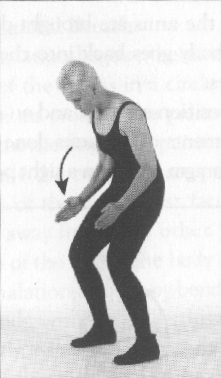
Fig. 289 |
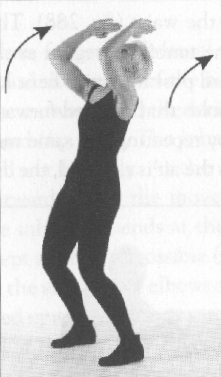
Fig. 290 |